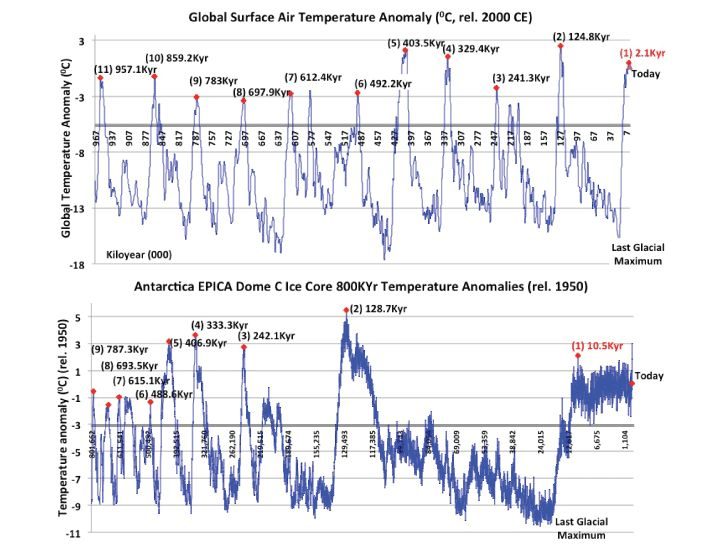
Earth entered a new ice age after the Holocene Climate Optimum
Polar and global climate optima, or peak glacial cycle temperatures (red dots), are specifically phased. In general, Antarctica’s climate optimum is reached before the Arctic’s, which is reached before the global climate optimum.
A number of datasets were used to understand glacial cycle temperature changes, their relative phasings, and what stage of the glacial cycle we occupy today. The reconstructed temperature data analyzed spans of 3,000,000 years (global),[1] 800,000 years (Antarctica Dome EPICA C),[2] 360,000 years (Antarctica Dome Fuji),[3] 248,000 years (Greenland Oxygen-18 isotope),[4] and 11,700 years[5] and 49,000 years[6] (Greenland). These provide an informative panorama of the earth’s changing climate and its historical glacial cycles. Antarctica’s Dome EPICA C and the global climate data are graphically displayed above.
The Holocene Climate Optimum was reached 10,500 years ago in Antarctica (Dome-C data), 8,000 years ago in the Arctic (Greenland data),[7] and 2,100 years ago globally, yielding a phasing gap of 8,400 years. This 8,400-year phasing gap is the longest in the last 800,000 years of glacial cycles, meaning the global climate optimum 2,100 years ago was already late.
Likewise, the interval between the Holocene Climate Optimum and its preceding climate optimum was the longest recorded interval in 800,000 years in Antarctic (a 121,800 year interval) and 2 million years globally (a 122,700 year interval). [8]
Based on the above-cited climate optima phasing gaps and climate optimum intervals, there is no justification for the Intergovernmental Panel on Climate Change (IPCC) proposing that the ice age lies 30,000 years ahead of us (see below). There is even less justification for thinking the ice age lies ahead of us today when you realize there is more polar ice present now than there was at the Holocene Climate Optimum (see link).
This means that the climate optima temperature peaks for Antarctica 10,500 years ago, Greenland 8,000 years ago, and globally 2,100 years ago, represented the end of the previous interglacial period. Based on the above graphics you can see that ice ages start after the climate optimum, as the temperatures begin to decline (from peak to right). The conclusion therefore is that this Ice Age started 8,000 and 10,500 years ago in the north and south poles respectively, and 2,100 years ago globally.
 Key data was extracted and tabulated (see above) to summarize the climate optima dates, the inter-climate optimum intervals, and the phasing gaps between the Antarctic and global climate optima for each glacial cycle.
Key data was extracted and tabulated (see above) to summarize the climate optima dates, the inter-climate optimum intervals, and the phasing gaps between the Antarctic and global climate optima for each glacial cycle.
The IPCC’s 30,000-Year Ice Age Deferral Is Statistically Falsifiable
There are crucially important statistical implications relating to the IPCC’s theory for delaying the next ice age by 30,000 years.[9],[10] The statistical implications have been ignored (I am assuming), and would automatically lead to the dismissal of this theoretical ice age delay. The statistical implications relate to how this delay adjusts the interval back to the previous ice age, the interglacial period duration, and the relative phasing gap between the Antarctic and global climate optima, when compared with all previous glacial cycles in the last 800,000 (Antarctica) and 2,000,000 (global) years.[11],[12]
By extending the start of the ice age another 30,000 years from its “real start” 2,100 years ago (global data), the interglacial period duration is extended. The last interglacial period started 19,600 years ago and ended 2,100 years ago at the Holocene Climate Optimum. Consequently, the interglacial period would increase from its existing 17,500 years to 49,600 years, rendering the revised 49,600-year interglacial period duration a statistically significant outlier (see the data table summary embedded in the citation).[13]
Similarly, by ignoring the global climate optimum 2,100 years ago and extending the interglacial period by another 30,000 years, one would be positing a new Holocene Climate Optimum 30,000 years in the future. Creating a new Holocene Climate Optimum would extend the already longest interval, going back to the previous climate optimum, from 122,700 years to 154,800 years.
Compared with all thirty-two preceding climate optima intervals in the last 2,026,800 years, this revised 154,800-year interval would become a statistically significant outlier. The original non-delayed climate optimum interval, while an outlier, was not a statistically significant one (See the data in the following citation).[14]
In the third statistical analysis, the timings for the last nine glacial cycle climate optima in Antarctica were compared with their corresponding global climate optima timings, to determine the phasing gap for each glacial cycle. In all but two glacial cycles, the climate optimum was reached first in Antarctica, and on average 2,100 years before it was reached globally. The global climate optimum 2,100 years ago already had the longest phasing gap with its corresponding Antarctic climate optimum, compared with all previous Antarctic and global phasing gaps in the past 800,000 years.
By delaying the Holocene Climate Optima 30,000 years, the phasing gap between Antarctica EPICA Dome-C (10,500 years ago) and the global (2,100 years ago) data changes from 8,400 years to 40,500 years, rendering this revised phasing gap a statistically significant outlier (See the data in the following citation).[15]
Delaying an ice age by 30,000 years cannot be statistically justified on at least three counts. By delaying the ice age 30,000 years a statistical outlier is created for interglacial durations, inter-climate optima intervals, and Antarctic-to-global climate optima phasing gaps (P-value <0.05 in all three of the above cited cases). In addition, by delaying the ice age another 30,000 years, the distribution of the data is changed from a normal distribution to a non-normal distribution profile. If normal science were operating in an unimpinged manner, it would emphatically reject the IPCC’s 30,000-year delay to the start of the next ice age.
[1] Bintanja, R. and R.S.W. van de Wal, “North American ice-sheet dynamics and the onset of 100,000-year glacial cycles.” Nature, Volume 454, 869-872, 14 August 2008. doi:10.1038/nature07158. National Centers for Environmental Information, NESDIS, NOAA, U.S. Department of Commerce. Global 3Ma Temperature, Sea Level, and Ice Volume Reconstructions. https://www.ncdc.noaa.gov/paleo-search/study/11933. Downloaded 10/27/2015.
[2] J.V. Jouzel et al., 2007, “Orbital and Millennial Antarctic Climate Variability over the Past 800,000 Years.” Science, Volume 317, No. 5839, 793-797, 10 August 2007. National Centers for Environmental Information, NESDIS, NOAA, U.S. Department of Commerce. EPICA Dome C – 800KYr Deuterium Data and Temperature Estimates. https://www.ncdc.noaa.gov/paleo/study/6080. Download data: Downloaded 08/02/2016.
[3] R.V. Uemura et al., 2012, “Ranges of moisture-source temperature estimated from Antarctic ice cores stable isotope records over glacial-interglacial cycles.” Climate of the Past, 8, 1109-1125. doi: 10.5194/cp-8-1109-2012. National Centers for Environmental Information, NESDIS, NOAA, U.S. Department of Commerce. Dome Fuji 360KYr Stable Isotope Data and Temperature Reconstruction. https://www.ncdc.noaa.gov/paleo-search/study/13121. Downloaded 05/05/2018.
[4] Sigfus J. Johnsen et al., 1997, “The d18O record along the Greenland Ice Core Project deep ice core and the problem of possible Eemian climatic instability.” Journal of Geophysical Research: Oceans, 102(C12), 26397-26410. doi: 10.1029/97JC00167. National Centers for Environmental Information, NESDIS, NOAA, U.S. Department of Commerce. GRIP Ice Core 248KYr Oxygen Isotope Data. https://www.ncdc.noaa.gov/paleo-search/study/17839.
[5] B.M. Vinther et al., 2009, “Holocene thinning of the Greenland ice sheet.” Nature, Vol. 461, pp. 385-388, 17 September 2009. National Centers for Environmental Information, NESDIS, NOAA, U.S. Department of Commerce. Greenland Ice Sheet Holocene d18O, Temperature, and Surface Elevation. doi:10.1038/nature08355. https://www.ncdc.noaa.gov/paleo-search/study/11148. Downloaded 05/05/2018.
[6] R.B. Alley, 2004, “GISP2 Ice Core Temperature and Accumulation Data.” National Centers for Environmental Information, NESDIS, NOAA, U.S. Department of Commerce. https://www.ncdc.noaa.gov/paleo/study/2475. Downloaded 05/05/2018.
[7] B.M. Vinther et al., 2009, “Holocene thinning of the Greenland ice sheet.” Nature, Vol. 461, pp. 385-388, 17 September 2009. National Centers for Environmental Information, NESDIS, NOAA, U.S. Department of Commerce. Greenland Ice Sheet Holocene d18O, Temperature, and Surface Elevation. doi:10.1038/nature08355. https://www.ncdc.noaa.gov/paleo-search/study/11148. Downloaded 05/05/2018.
[8] Data: (1) J.V. Jouzel et al., 2007, “Orbital and Millennial Antarctic Climate Variability over the Past 800,000 Years.” Science, Volume 317, No. 5839, 793-797, 10 August 2007. National Centers for Environmental Information, NESDIS, NOAA, U.S. Department of Commerce. EPICA Dome C – 800KYr Deuterium Data and Temperature Estimates. https://www.ncdc.noaa.gov/paleo/study/6080. Download data: Downloaded 08/02/2016. (2) Bintanja, R. and R.S.W. van de Wal, “North American ice-sheet dynamics and the onset of 100,000-year glacial cycles.” Nature, Volume 454, 869-872, 14 August 2008. doi:10.1038/nature07158. National Centers for Environmental Information, NESDIS, NOAA, U.S. Department of Commerce. Global 3Ma Temperature, Sea Level, and Ice Volume Reconstructions. https://www.ncdc.noaa.gov/paleo-search/study/11933. Downloaded 10/27/2015. (3) R.V. Uemura et al., 2012, “Ranges of moisture-source temperature estimated from Antarctic ice cores stable isotope records over glacial-interglacial cycles.” Climate of the Past, 8, 1109-1125. doi: 10.5194/cp-8-1109-2012. National Centers for Environmental Information, NESDIS, NOAA, U.S. Department of Commerce. Dome Fuji 360KYr Stable Isotope Data and Temperature Reconstruction. https://www.ncdc.noaa.gov/paleo-search/study/13121. Downloaded 05/05/2018. Personal Research: Based on the above-cited climate data the climate optima timings and inter-climate optima intervals were tabulated using the Dome Fuji, EPICA Dome-C, and Greenland ice core data. This table (at the start of the endnotes, referencing this endnote) also details 787,300 years of Antarctic-to-global climate optima phasing gaps (Kiloyears) for both EPICA Dome-C and Dome-Fuji.
[9] IPCC Working Group 1 (AR4) deferred the ice age 30,000 years without peer review: IPCC, Climate Change 2007: The Physical Science Basis. Contribution of Working Group I to the Fourth Assessment Report of the Intergovernmental Panel on Climate Change [Solomon, S., D. Qin, M. Manning, Z. Chen, M. Marquis, K.B. Averyt, M. Tignor and H.L. Miller (eds.)]. Cambridge University Press, Cambridge, United Kingdom and New York, NY, USA, 996 pages [Exposé: See page 56, Box TS.6. “The Milankovitch, or ‘orbital’ theory of the ice ages is now well developed. Ice ages are generally triggered by minima in high-latitude NH summer insolation, enabling winter snowfall to persist through the year and therefore accumulate to build NH glacial ice sheets.” Followed by, “Available evidence indicates that the current warming will not be mitigated by a natural cooling trend towards glacial conditions. Understanding of the Earth’s response to orbital forcing indicates that the Earth would not naturally enter another ice age for at least 30,000 years. {6.4, FAQ 6.1}.” See page 85 section TS.6.2.4 Paleoclimate under “Robust Findings” “It is very unlikely that the Earth would naturally enter another ice age for at least 30,000 years. {6.4}”). Critique: There is a statistical consequence in delaying the ice age by 30,000-years because this delay impacts the interglacial period duration, the inter-climate optimum interval, and global-to-Antarctica climate optimum phasing gaps relative to all other glacial cycles for the global (2 million years), Antarctic (800,000 years) and Arctic (248,000 years) climate data. This ice age delay hypothesis is being passed off as though it is a scientific fact, when in reality it is an unproven, non-peer reviewed, and readily falsifiable hypothesis (see Revolution, Chapters 2-4).].
[10] IPCC Working Group 1 (AR5) deferred the ice age 30,000 years without peer review: IPCC, 2013: Climate Change 2013: The Physical Science Basis. Contribution of Working Group I to the Fifth Assessment Report of the Intergovernmental Panel on Climate Change [Stocker, T.F., D. Qin, G.-K. Plattner, M. Tignor, S.K. Allen, J. Boschung, A. Nauels, Y. Xia, V. Bex and P.M. Midgley (eds.)]. Cambridge University Press, Cambridge, United Kingdom and New York, NY, USA, 1535 pages. [Exposé; See Page 70, “It is virtually certain that orbital forcing will be unable to trigger widespread glaciation during the next 1000 years. Paleoclimate records indicate that, for orbital configurations close to the present one, glacial inceptions only occurred for atmospheric CO2 concentrations significantly lower than pre-industrial levels. Climate models simulate no glacial inception during the next 50,000 years if CO2 concentrations remain above 300 ppm. {5.8.3, Box 6.2}.” Given the IPCC legacy of forecasting failure this non-peer reviewed assumption should be treated with serious caution.].
[11] Bintanja, R. and R.S.W. van de Wal, “North American ice-sheet dynamics and the onset of 100,000-year glacial cycles.” Nature, Volume 454, 869-872, 14 August 2008. doi:10.1038/nature07158. National Centers for Environmental Information, NESDIS, NOAA, U.S. Department of Commerce. Global 3Ma Temperature, Sea Level, and Ice Volume Reconstructions. https://www.ncdc.noaa.gov/paleo-search/study/11933. Downloaded 10/27/2015.
[12] J. V. Jouzel et al., 2007, “Orbital and Millennial Antarctic Climate Variability over the Past 800,000 Years.” Science, Volume 317, No. 5839, 793-797, 10 August 2007. National Centers for Environmental Information, NESDIS, NOAA, U.S. Department of Commerce. EPICA Dome C – 800KYr Deuterium Data and Temperature Estimates. https://www.ncdc.noaa.gov/paleo/study/6080. Download data: Downloaded 08/02/2016.
[13] Data: Bintanja, R. and R.S.W. van de Wal, “North American ice-sheet dynamics and the onset of 100,000-year glacial cycles.” Nature, Volume 454, 869-872, 14 August 2008. doi:10.1038/nature07158. National Centers for Environmental Information, NESDIS, NOAA, U.S. Department of Commerce. Global 3Ma Temperature, Sea Level, and Ice Volume Reconstructions. https://www.ncdc.noaa.gov/paleo-search/study/11933. Downloaded 10/27/2015. Personal Research: The following table was created to summarize 965,300 years of global interglacial periods (Kiloyears). A Grubb’s test (extreme studentized deviate) was performed to determine if the IPCC’s proposed 30,000-year extension to the Holocene interglacial period created a statistically significant outlier in this group of eleven glacial cycle comparators. To test the statistical validity, the current interglacial duration of 17,500 years was extended by 30,000, plus 2,100 years from its existing climate optimum peak to bring it up to today, yielding a revised 49,600 year interglacial period. By extending this current interglacial by 30,000 years the group interglacial duration mean was 21.1Kyr, standard deviation 11.2Kyr, N=11, and an outlier was detected (two-sided P<0.05). The critical value of Z = 2.35. A goodness of fit test was performed with the original data using the d’Agostino-Pearson test: P = 0.386, indicating the original group was not different from a Gaussian or normal distribution. On this basis the Grubbs test was selected to test for an outlier. By delaying the Holocene 30,000 years the interglacial period was extended to 49,600 years and the d’Agostino-Pearson test: P = 0.011. This 30,000 year interglacial extension changed the data-population distribution to a non-normal or non-Gaussian distribution. This change in data distribution adds further support that the 30,000-year delay can not be statistically justified.
[14] Data: Bintanja, R. and R.S.W. van de Wal, “North American ice-sheet dynamics and the onset of 100,000-year glacial cycles.” Nature, Volume 454, 869-872, 14 August 2008. doi:10.1038/nature07158. National Centers for Environmental Information, NESDIS, NOAA, U.S. Department of Commerce. Global 3Ma Temperature, Sea Level, and Ice Volume Reconstructions. https://www.ncdc.noaa.gov/paleo-search/study/11933. Downloaded 10/27/2015. Personal Research: The following table data summary was created detailing 2,026,800 years of global climate optima timings and intervals (from peak-to-peak; Kiloyears). Without any change to the 2.1Kyr climate optimum 2,100 years ago i.e., without a 30,000-year extension to the Holocene interglacial period, the current largest climate optimum interval of 122.7 kiloyears (2.1-124.8Kyr peak) is not a statistically significant outlier (P>0.05) compared with the comparator group (N=33). However, when this interglacial period is extended 30,000 years the revised climate optima interval (154.8 kiloyears) becomes a statistically significant outlier (P<0.05). For the revised dataset (with 30,000-year extension): the Mean = 62.3, standard deviation = 30.2, N = 33. Outlier detected? Yes. Significance level: 0.05 (two-sided). Critical value of Z: 2.95. A goodness of fit was pre-assessed for the original unmodified data (i.e., no 30Kyr delay) using the d’Agostino-Pearson test: P = 0.095. On this basis the Grubb’s outlier test was selected because the original data was normally distributed. When the 122.7Kyr climate optimum interval was substituted with the 154.8Kyr data point the d’Agostino-Pearson test: P = 0.011. This 30,000-year modification changed the data-population distribution to a non-normal distribution. This change in data distribution adds further support that the 30,000-year delay can not be statistically justified.
[15] Data: (1) Jouzel, J., V. et al. 2007. “Orbital and Millennial Antarctic Climate Variability over the Past 800,000 Years.” Science, Volume 317, No. 5839, 793-797, 10 August 2007. National Centers for Environmental Information, NESDIS, NOAA, U.S. Department of Commerce. EPICA Dome C – 800KYr Deuterium Data and Temperature Estimates. https://www.ncdc.noaa.gov/paleo/study/6080. Download data: Downloaded 08/02/2016. (2) R. Bintanja and R.S.W. van de Wal, North American ice-sheet dynamics and the onset of 100,000-year glacial cycles. Nature, Volume 454, 869-872, 14 August 2008. doi:10.1038/nature07158. National Centers for Environmental Information, NESDIS, NOAA, U.S. Department of Commerce. Global 3Ma Temperature, Sea Level, and Ice Volume Reconstructions. https://www.ncdc.noaa.gov/paleo-search/study/11933. Downloaded 10/27/2015. Personal Research: The data is tabulated above (at the start of the endnotes, referencing this endnote). detailing 787,300 years of Antarctic-to-global climate optima phasing gaps (Kiloyears). A Grubb’s test (extreme studentized deviate) was performed on the Antarctic-to-global climate optima phasing gaps to determine if the IPCC’s proposed 30,000 year ice age delay created a statistically significant outlier from the other 8 glacial cycle comparator phasing gaps (Antarctica versus global; glacial cycles 1-9). By delaying the Holocene Climate Optima 30,000 years, the phasing gap changes from the current 8,400 years to a statistically significant 40,500 years (P<0.05)(40,500 years =30,000+2,100+8,400 years). The 30,000-year phasing gap increase was only applied to the global climate data’s climate optimum because Antarctica’s climate optimum was set in the ice record 10,500 years ago and new ice has accumulated since, indicating its ice age has already started (i.e., the inner dome is 100 meters higher today than it was at the Holocene Climate Optimum, see Chapter 3). A goodness of fit test was performed with the original data using the d’Agostino-Pearson test: P = 0.678, indicating the original group was not different from a Gaussian or normal distribution. On this basis the Grubbs test was selected to test for an outlier. By delaying the Holocene 30,000 years the phasing gap was increased to 40,500 years and the d’Agostino-Pearson test: P< 0.001. This 30,000-year interglacial extension changed the data-population distribution from a normal to a non-normal distribution. This change in data distribution adds further support that the 30,000-year delay can not be statistically justified.

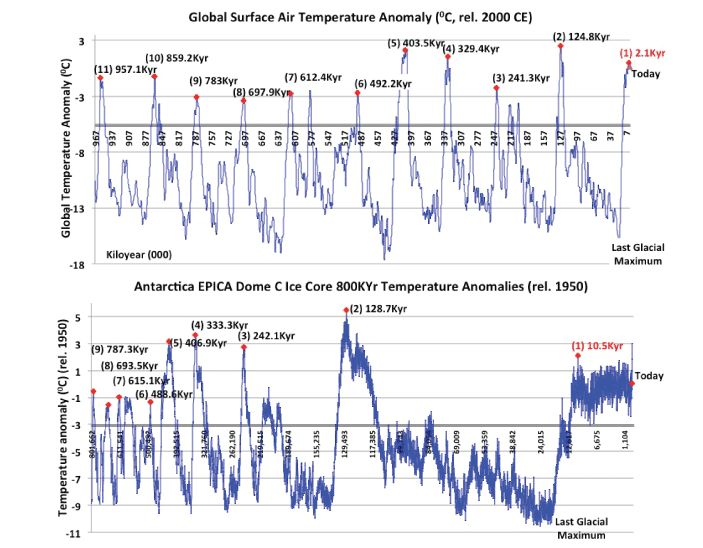
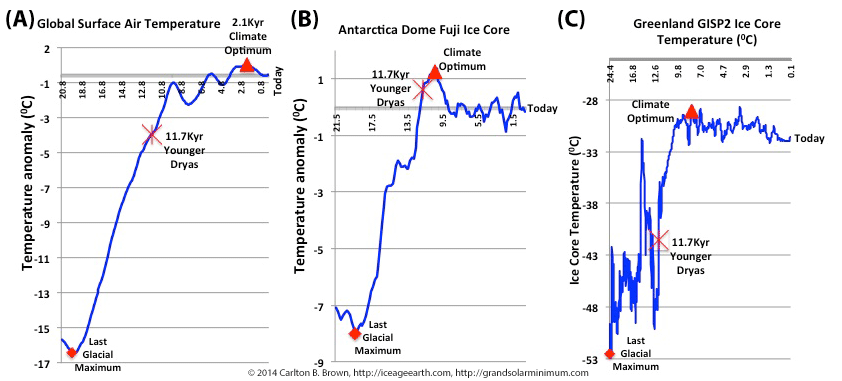
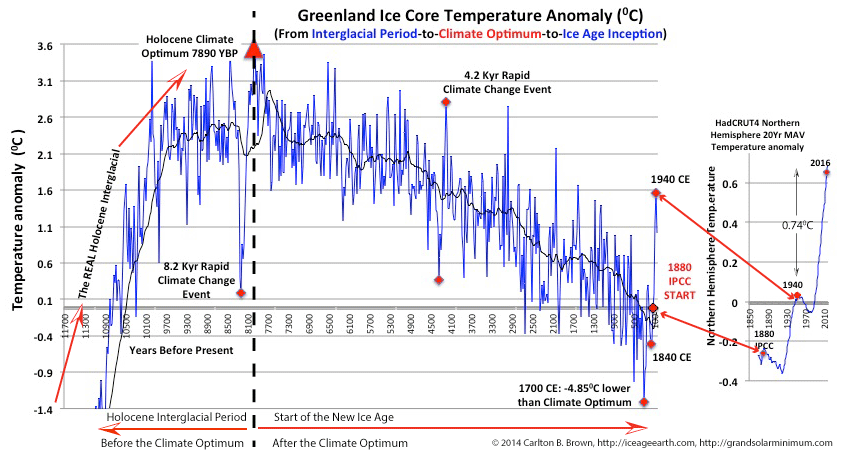
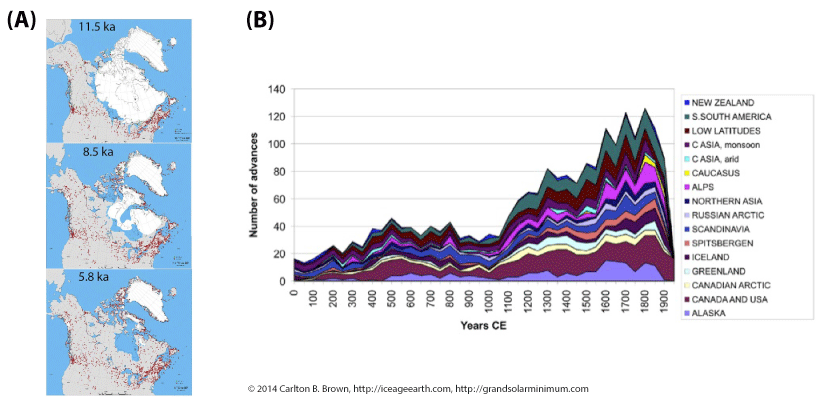
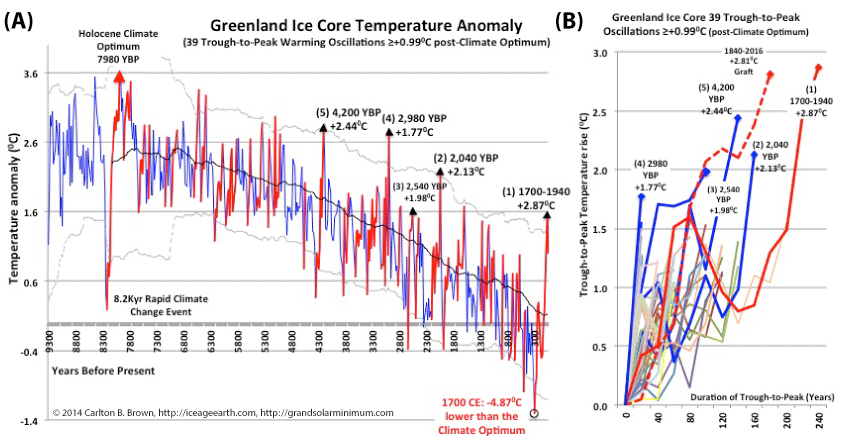


Recent Comments